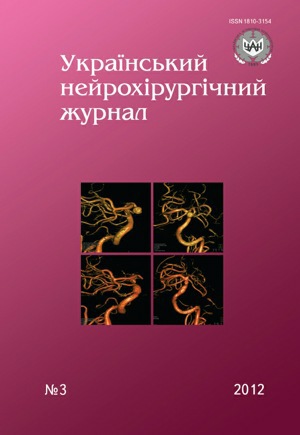Clinical observation of surgical treatment of posterior cerebral artery aneurysm
DOI:
https://doi.org/10.25305/unj.60852Keywords:
arterial aneurysm, surgical treatment, posterior cerebral arteryAbstract
Introduction. Surgical treatment of brain ruptured arterial aneurysms (AA) has no alternative and includes both microsurgical and endovascular interventions. In some cases AA microsurgical clipping is the only possible and adequate method of treatment.
The most dangerous and difficult AA are aneurysms of cerebral arterial posterior semi-ring, in particular, located on basilar artery (BA) bifurcation and R1 segment of posterior cerebral artery (PCA).
Material and methods. The result of surgical treatment of AA of left PCA initial part is given. Transcranial clipping of AA neck was performed under dynamic ultrasonic Doppler examination (UDE) control using flexible intraoperative sensor of catheter-type with frequency 16 MHz. Microsurgical access to BA bifurcation, R1 segment of PCA was used, aneurysmal neck blockage was made through left carotid-oculomotor triangle under UDE control from optic-carotid triangle. The operation was planned on the base of neurovisualizing methods results complex assessment (MRI, CT, cerebral angiography, UDE) with appropriate control after operation.
Results and their discussion. Surgical treatment was performed routinely, the patient’s general state was satisfactory. The combined microsurgical access to initial PCA segment was used. Intraoperative UDE ensured the possibility to estimate hemodynamic situation in vessels of the appropriate zone after surgical intervention, and to control the extent of radicalism of operation.
Conclusion. Technical possibilities of PCA AA microsurgical direct exclusion are the basis of differentiated application of intracranial methods at unproved advantages or technical difficulties of endovascular method under condition of surgical tactics planning and corresponding technical providing.
References
1. Krylov V V, Tkachev V V, Dobrovolskiy GF. Mikrokhirurgiya anevrizm villiziyeva mnogougolnika [Microsurgery circle of Willis aneurysms]. Moscow: Antidor; 2004. Russian.
2. Lawton MT. Seven aneurysms. N.Y.: Thieme; 2011.
3. Sanai N, Tarapore P, Lee A, Lawton M. The current role of microsurgery for posterior circulation aneurysms: a selective approach in the endovascular era. Neurosurgery. 2008;62(6):1236-1253. [CrossRef] [PubMed]
4. Ito Z. Microsurgery of cerebral aneurysms: Atlas. Tokyo; 1985.
5. Yasargil MG. Microsurgery. Stuttgart; New York: Georg Thieme Verlag; 1984.
6. Lawton M. Basilar Apex Aneurysms: Surgical Results and Perspectives from an Initial Experience. Neurosurgery. 2002;50(1):1-10. [CrossRef] [PubMed]
7. Lawton M, Daspit C, Spetzler R. Transpetrosal and combination approaches to skull base lesions. Clin Neurosurg. 1996;43:91-112. [PubMed]
8. Shekhtman OD. Ultrazvukovaya kontaktnaya dopplerografiya v khirurgii anevrizm golovnogo mozga. [Contact Ultrasonic Doppler surgery brain aneurysm]. [dissertation]. Moscow (Russia); 2006. Russian.
9. Gilsbach J, Hassler W. Intraoperative doppler and real time sonography in neurosurgery. Neurosurgical Review. 1984;7(2-3):199-208. [CrossRef] [PubMed]
10. Stendel R. Intraoperative microvascular Doppler ultrasonography in cerebral aneurysm surgery. Journal of Neurology, Neurosurgery & Psychiatry. 2000;68(1):29-35. [CrossRef] [PubMed]
11. Thornton J, Bashir Q, Aletich V, Debrun G, Ausman J, Charbel F. What percentage of surgically clipped intracranial aneurysms have residual necks? Neurosurgery. 2000;46(6):1294-1300. [CrossRef] [PubMed]
Downloads
Published
How to Cite
Issue
Section
License
Copyright (c) 2012 Svetlana Litvak, Volodymyr Moroz, Marina Globa

This work is licensed under a Creative Commons Attribution 4.0 International License.
Ukrainian Neurosurgical Journal abides by the CREATIVE COMMONS copyright rights and permissions for open access journals.
Authors, who are published in this Journal, agree to the following conditions:
1. The authors reserve the right to authorship of the work and pass the first publication right of this work to the Journal under the terms of Creative Commons Attribution License, which allows others to freely distribute the published research with the obligatory reference to the authors of the original work and the first publication of the work in this Journal.
2. The authors have the right to conclude separate supplement agreements that relate to non-exclusive work distribution in the form of which it has been published by the Journal (for example, to upload the work to the online storage of the Journal or publish it as part of a monograph), provided that the reference to the first publication of the work in this Journal is included.









